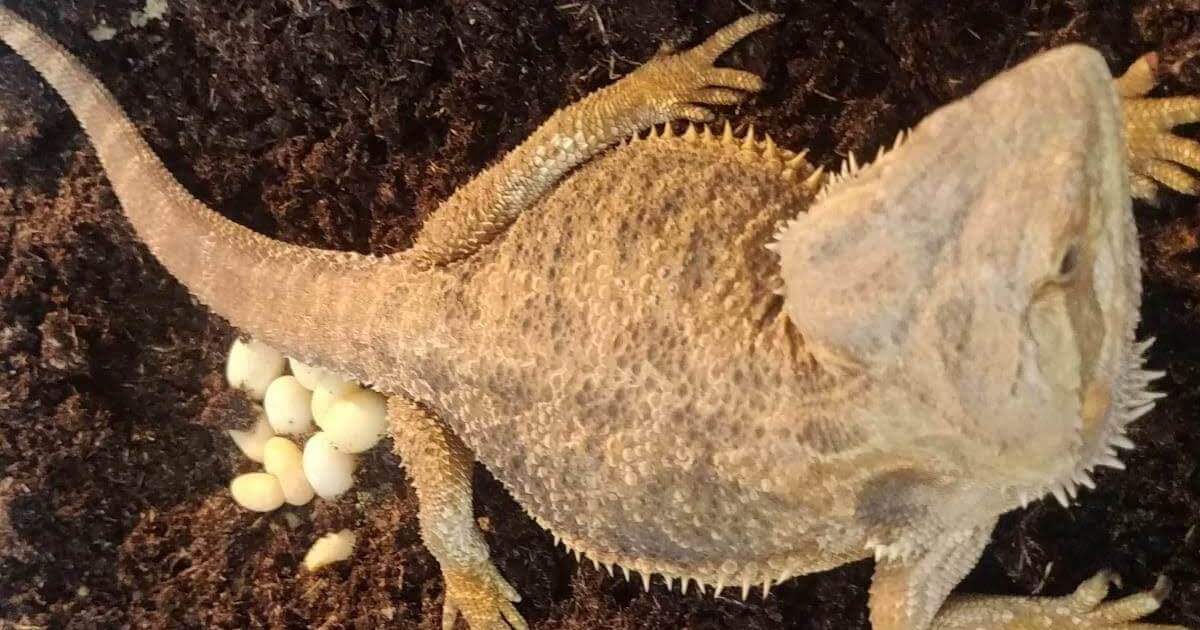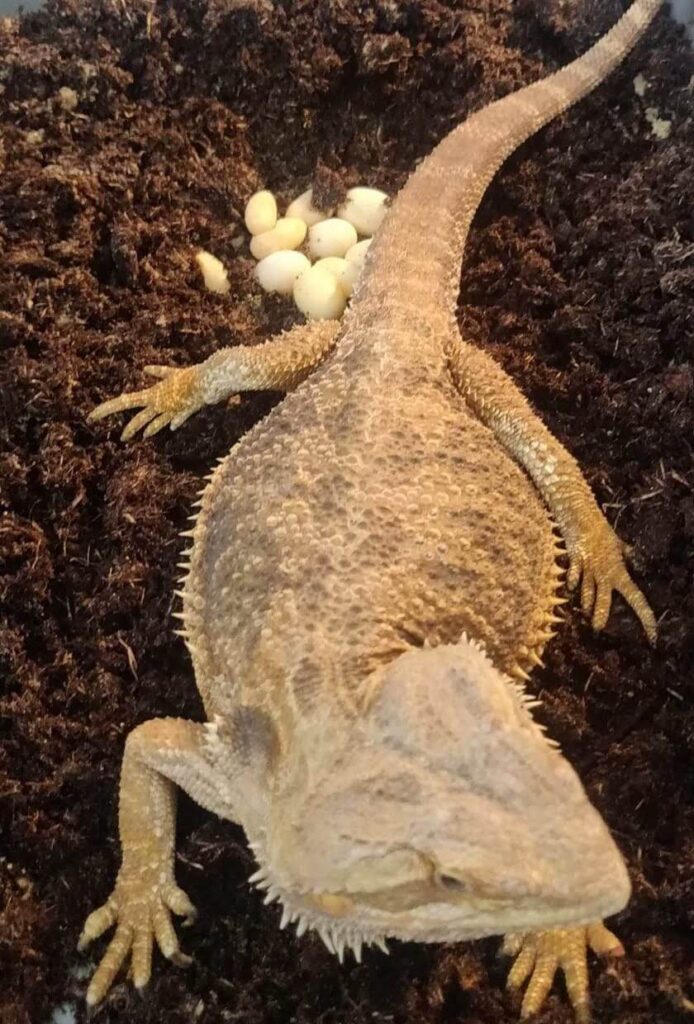5 Signs Your Bearded Dragon Is Pregnant & What To Do
In this post we learn how to tell if your bearded dragon is pregnant, even if they’ve not been with a male, and what you need to do to help her

Last Updated: June 30th, 2022
By: Claire
Table of Contents
If you’ve arrived here because you’re wondering whether it’s safe to keep a bearded dragon while you’re pregnant, then click here to read our article about bearded dragons and pregnant women instead.
Female bearded dragons can reach sexual maturity as early as six months, this means that they are capable of ovulating and producing eggs and becoming pregnant. If you want to breed your bearded dragons you should wait until the female reaches at least eighteen months so that she is strong enough to deal with it. Bearded dragons are able to develop a clutch of eggs without being mated. A female that is carrying a clutch of eggs is often referred to as gravid which literally means to be pregnant. If you think your bearded dragon is pregnant we have the information you need to help her through it.
How To Tell If Your Bearded Dragon Is Pregnant / Gravid
There are several key signs that strongly suggest if a female bearded dragon is gravid and soon to lay a clutch of eggs……
Signs That A Bearded Dragon Is Pregnant and Ready To Lay Eggs
- Have you noticed that your female bearded dragon is becoming restless?
- Has she suddenly started to dig?
- Is she purposefully scratching around her vivarium?
- Have you noticed that she recently had a voracious appetite then suddenly lost interested in food?
If the answer is yes to any these questions then she probably has a belly full of eggs. The behaviour she is displaying suggests she is looking for somewhere to lay her eggs and very soon.
Physical Symptoms of a Pregnant Bearded Dragon
You may also notice that her shape has changed or changing and she is looking more rounded and “fuller”. She may become slow and clumsy. It is also not uncommon for her to not to interact much and refuse to be held due her being preoccupied with the task of preparing to lay.
You can usually confirm this by very carefully palpating her abdomen, if she is pregnant you will be able to feel the outline of several eggs. It will resemble the feeling of a bag of marbles. You must be extremely gentle and careful when palpating a pregnant bearded dragon’s abdomen as the eggs can be quite delicate (especially if she is at risk of egg binding, which we discuss later) and you can rupture the eggs. This will make your bearded dragon extremely sick very quickly.
If bearded dragon is pregnant and begins frantically / frequently digging and scratching around the enclosure, these are key signs she wants to lay eggs very soon. She is looking for a suitable place to do this. Female bearded dragons that can’t find a suitable area to lay her eggs could become egg bound which will require specialist veterinary intervention. We’ll look at egg binding (dystocia) in more detail later in the post.
It is worth noting that if your “male” bearded dragon is displaying any of these behaviours your male could in fact be a female. It is extremely common for bearded dragons to be mis-sexed especially by chain pet stores and inexperienced breeders and owners. If you think your male bearded dragon could be female find out how to sex a bearded dragon.
Can a Female Bearded Dragon Lays Eggs Without a Male?
This is a really common question and to which the answer is YES, bearded dragons can lay eggs without a male. However, not all bearded dragons will lay eggs without a male. But don’t be surprised if yours does.
Female bearded dragons can produce and go full term with unfertilised eggs. There are a couple of theories for this, the first being that if there is male within the vicinity of the female, for example close by in another enclosure. His pheromones will stimulate her urge to reproduce.
The other reason is thought to be well fed / overfed females. There has been some research on bearded dragons that suggest that over feeding females will stimulate egg production without a male presence. In the wild females will become gravid and search for a male to mate with when there is an abundance of food. In captivity there is often always an abundance of food available that they don’t have to hunt or forage for.
Whatever the reason she is gravid the process and requirements are the same.
How Long Is A Bearded Dragon Pregnant?
Bearded dragons are pregnant for around 4 to 6 weeks after successfully mating. After the eggs are laid, the baby bearded dragons will usually take around 55 to 75 days to hatch from the eggs. Of course, if your bearded dragon has never been mated, it’ll be almost impossible for you to know when she’s going to actually lay the eggs, except for the signs we listed above giving you an indicator.
Pregnancy in bearded dragons requires a lot of calcium, so she’ll benefit from extra calcium dusted on her vegetables and feeder insects.
Do Bearded Dragons Need Somewhere To Lay Eggs?
If your female has no suitable area to lay her eggs it would be advisable to provide a nesting or egg laying box so she can dig and lay her eggs. Inadequate nesting area will result in the female restlessly digging in multiple areas making digging attempts almost anywhere. Having nowhere to lay eggs can result in the female bearded dragon becoming stressed, weak and exhausted.
Towards the end of a normal gestation the female bearded dragon may not eat but will remain alert and active. However, gestation problems can arise, the most common of which is dystocia or egg binding. This means that the bearded dragon is unable lay her clutch of eggs. Dystocia occurs for a number of reasons including having no suitable place to lay her eggs.
If a bearded dragon is egg bound they will be lethargic, appear depressed and non responsive you may notice a prolapsed cloaca this will be from straining from attempts to lay. They can also prolapse after laying this could be due to straining or that not all the eggs have passed especially if she has been disturbed while laying.
Preparing and Making a Nesting Area
A good time to prepare a nesting area is as soon as you notice your gravid female starting to dig. This is a good indicator that she is getting ready to lay and is looking for somewhere suitable to lay.
If you are already using a loose substrate you might notice mounds appearing all around the vivarium. Don’t assume that if you are using a loose substrate this will be adequate for nesting.
Making a Nesting Area For Pregnant Bearded Dragon
To prepare a nesting area you will need a large, deep container and some form-able substrate eg. sand and soil. the material needs to be moist (not wet) and substantial enough to hold it form when its dug into do not collapse when dry.
I have found that a mix of sand, soil and vermiculite works best. The reason for vermiculite is it will retain moisture. Vermiculite is available in reptile retailers but can also be bought from garden centres more cheaply. Because of its ability to retain moisture gardeners mix in to the plant soil.
The soil where possible should be sterile, if unsure you can bake it at a low temp for 30 mins. If you are using sand make sure its children’s play sand.

How Many Eggs Do Bearded Dragons Lay?
Typically a pregnant bearded dragon will lay between 15 – 30 eggs at a time. And she may lay up to 6 times per year – although that figure is at the very top of the range. Most will only lay once or twice a year, with each clutch of eggs numbering around the 15 – 30 mark.
What Should I Do After My Bearded Dragon Lays Eggs?
After your bearded dragon has laid her eggs she will be exhausted, her appearance will have changed significantly. She will look extremely skinny and wrinkly and be much lighter, this is normal. You may notice that the fat pads on the top of her head are sunken and diminished and the fat pads around her tail will likely also be depleted. She’ll need some extra hydration and extra feeding once the eggs are laid.
The process of egg production, nesting/digging and laying depletes the female of calcium and energy. Supplements especially calcium will need to be increased temporarily after the eggs are laid. She will require additional protein and hydration too.
What is Dystocia / Egg Binding?
Dystocia or post ovulatory follicular stasis, commonly referred to egg binding is a condition where for what ever reason the animal is unable to lay their eggs and the eggs become “stuck” in transit. All creatures that lay eggs have the potential to become egg bound and bearded dragons are no exception. There are many reasons that a gravid female can become egg bound.
Most Common Reasons for Dystocia / Egg Binding are:
- First time breeding females
- Previous egg binding
- Female bearing infertile clutches
The reasons that can cause the above to happen are often due to the inability for the eggs to pass through the oviduct and or the cloaca due to either:
Common Unpreventable Causes for Dystocia:
- The eggs are too large
- Multiple eggs bound together
- Anatomical abnormalities
- There is an obstruction preventing eggs passing.
- Or an abscess
The above reasons are something we have no control over and will need some intervention from a vet to pass the eggs. Egg binding can still occur in the absence of the aforementioned causes. The following causes are something we have the ability to prevent.
Most Common Preventable Causes For Dystocia:
- Poor husbandry
- Inadequate temperatures
- improper nesting area – will notice erratic behaviour and frantic relentless digging
- Poor or inadequate diet
- Calcium deficiency
- Dehydration
- Overall poor condition of the female
Dystocia is often life threatening and will usually require specialist veterinary surgical intervention.
The Brisbane Bird and Exotics Veterinary Service in Australia now recommend de-sexing female bearded dragons who are not intended for breeding as they state the surgery is safer to do as a preventative measure rather than under emergency conditions such as egg-binding or pre-ovulatory follicular stasis. They also note that calcium deficiency is one of the major causes of egg binding.
Summary
We’ve seen in this post that bearded dragons can lay eggs even without a male being present – although the presence of a male, even if they’ve not been mated, is probably going to make it more likely that she will lay.
We’ve also looked at the way the egg laying process affects your beardie and noted that she’ll likely need some extra help with re-hydrating (so some vegetables that are high in water content such as cucumber can be added to her salad) and will need to replenish calcium so high calcium foods and extra supplementation are going to be needed.
And finally we looked at some of the risks associated with the egg-laying cycle of bearded dragons, such as dystocia (inability to pass the eggs). We showed that husbandry can play an important role in reducing the risk of dystocia, but also noted that some things are just beyond our control, in which case veterinary advice should be sought.
We hope you found this post useful. If you did please feel free to share it using the buttons below. If you have any questions please drop us a comment using the form below.
